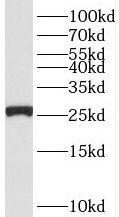Products
RPS3 antibody
| Size | Price |
|---|---|
| 100µg | Inquiry |
- SPECIFICATIONS
- FIGURES
- CONDITIONS
- FAQS
- Product Name
- RPS3 antibody
- Catalogue No.
- FNab07476
- Size
- 100μg
- Form
- liquid
- Purification
- Immunogen affinity purified
- Purity
- ≥95% as determined by SDS-PAGE
- Clonality
- polyclonal
- Isotype
- IgG
- Storage
- PBS with 0.02% sodium azide and 50% glycerol pH 7.3, -20℃ for 12 months(Avoid repeated freeze / thaw cycles.)
- Immunogen
- ribosomal protein S3
- Alternative Names
- Small ribosomal subunit protein uS3|40S ribosomal protein S3|RPS3 antibody
- UniProt ID
- P23396
- Observed MW
- 26.7 kDa
- Tested Applications
- ELISA, WB, IHC
- Recommended dilution
- WB: 1:500-1:2000; IHC: 1:20-1:200
 mouse brain tissue were subjected to SDS PAGE followed by western blot with FNab07476(RPS3 antibody) at dilution of 1:1000
mouse brain tissue were subjected to SDS PAGE followed by western blot with FNab07476(RPS3 antibody) at dilution of 1:1000
 Immunohistochemistry of paraffin-embedded human ovary tumor using FNab07476(RPS3 antibody) at dilution of 1:50
Immunohistochemistry of paraffin-embedded human ovary tumor using FNab07476(RPS3 antibody) at dilution of 1:50
- Background
- Involved in translation as a component of the 40S small ribosomal subunit(PubMed:8706699). Has endonuclease activity and plays a role in repair of damaged DNA(PubMed:7775413). Cleaves phosphodiester bonds of DNAs containing altered bases with broad specificity and cleaves supercoiled DNA more efficiently than relaxed DNA(PubMed:15707971). Displays high binding affinity for 7,8-dihydro-8-oxoguanine(8-oxoG), a common DNA lesion caused by reactive oxygen species(ROS)(PubMed:14706345). Has also been shown to bind with similar affinity to intact and damaged DNA(PubMed:18610840). Stimulates the N-glycosylase activity of the base excision protein OGG1(PubMed:15518571). Enhances the uracil excision activity of UNG1(PubMed:18973764). Also stimulates the cleavage of the phosphodiester backbone by APEX1(PubMed:18973764). When located in the mitochondrion, reduces cellular ROS levels and mitochondrial DNA damage(PubMed:23911537). Has also been shown to negatively regulate DNA repair in cells exposed to hydrogen peroxide(PubMed:17049931). Plays a role in regulating transcription as part of the NF-kappa-B p65-p50 complex where it binds to the RELA/p65 subunit, enhances binding of the complex to DNA and promotes transcription of target genes(PubMed:18045535). Represses its own translation by binding to its cognate mRNA(PubMed:20217897). Binds to and protects TP53/p53 from MDM2-mediated ubiquitination(PubMed:19656744). Involved in spindle formation and chromosome movement during mitosis by regulating microtubule polymerization(PubMed:23131551). Involved in induction of apoptosis through its role in activation of CASP8(PubMed:14988002). Induces neuronal apoptosis by interacting with the E2F1 transcription factor and acting synergistically with it to up-regulate pro-apoptotic proteins BCL2L11/BIM and HRK/Dp5(PubMed:20605787). Interacts with TRADD following exposure to UV radiation and induces apoptosis by caspase-dependent JNK activation(PubMed:22510408).
How many times can antibodies be recycled?
First, usually it's not suggested to recycle antibodies. After use, buffer system of antibodies has changed. The storage condition of recycled antibodies for different customers also varies. Thus, the performance efficiency of recycled antibodies can’t be guaranteed. Besides, FineTest ever conducted the antibody recycling assay. Assay results show recycling times of different antibodies also varies. Usually, higher antibody titer allows more repeated use. Customers can determine based on experimental requirements.
Notes: After incubation, we recycle rest antibodies to centrifuge tube and store at 4℃. High titer antibodies can be stored for a minimum of one week. Reuse about three times.
What are components of FineTest antibody buffer?
Components of FineTest antibody buffer are usually PBS with proclin300 or sodium azide, BSA, 50% glycerol. Common preservative is proclin300 or sodium azide, which is widely applied in the lab and industry.
How about the storage temperature and duration of FineTest antibodies?
Most antibodies are stored at -20℃. Directly-labeled flow cytometry antibodies should be stored at 2 - 8℃. The shelf life is one year. If after sales issues for purchased antibodies appear, return or replacement is available. Usually, antibodies can be still used after the one-year warranty. We can offer technical support services.
Is dilution required for FineTest antibodies? What’s the dilute solution?
Directly-labeled flow cytometry antibodies are ready-to-use without dilution. Other antibodies are usually concentrated. Follow the dilution ratio suggested in the manual. Dilute solution for different experiments also varies. Common antibody dilution buffers are acceptable(e.g. PBST, TBST, antibody blocking buffer).
How to retrieve antibodies for immunohistochemistry?
Common retrieval buffers: Tris-EDTA Buffer(pH 9.0); Citrate Buffer(pH 6.0)
Heat induced antibody retrieval:
Method 1: Water-bath heating: Put the beaker with retrieval buffer and slide in the boiling water bath. Keep the boiling state for 15min. Naturally cool to room temperature;
Method 2: Microwave retrieval: Put the beaker with retrieval buffer and slide in the microwave oven. Heat at high power for 5min, Switch OFF for 3min, Heat at medium power for 5min. Naturally cool to room temperature.
How to choose secondary antibodies?
(1) Secondary antibodies react with primary antibodies. Thus, secondary antibodies should be against host species of primary antibodies. E.g. If the primary antibody is derived from rabbit, the relevant secondary antibody should be against rabbit. E.g. goat anti rabbit or donkey anti rabbit.
(2) Choose secondary antibody conjugates according to the experimental type, e.g. ELISA, WB, IHC etc. Common enzyme conjugated secondary antibodies are labelled by HRP, AP etc. Fluorescin or dye labelled secondary antibodies are applied in immunofluorescence and flow cytometry(e.g. FITC, Cy3).
